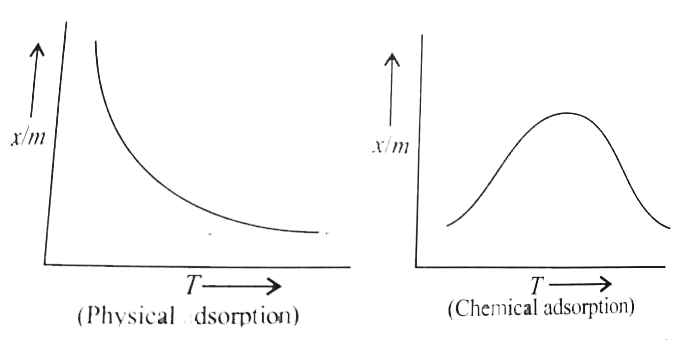Select the correct statements .
(i) Physical adsorption is weak, multilayer, non-directional and non-specific.
(ii) Chemical adsorption is strong, unilayer, directional and strong
(iii) Chemical adsorption decreases with temperature
(iv) Chemical adsorption is more stronger than physical adsorption
(i) and (iii) only
(i), (ii) and (iv) only
(iii) only
All of these.
The correct Answer is:B
To solve the question, we need to evaluate each of the given statements about physical and chemical adsorption and determine which ones are correct.
1. Evaluate Statement (i):
- Statement: Physical adsorption is weak, multilayer, non-directional, and non-specific.
- Analysis: Physical adsorption, also known as physisorption, involves weak van der Waals forces. It can form multiple layers (multilayer) and is characterized by being non-directional and non-specific.
- Conclusion: This statement is true.
2. Evaluate Statement (ii):
- Statement: Chemical adsorption is strong, unilayer, directional, and strong.
- Analysis: Chemical adsorption (chemisorption) involves the formation of strong chemical bonds, is typically unilayer (one layer), and is directional due to the nature of chemical bonding.
- Conclusion: This statement is true.
3. Evaluate Statement (iii):
- Statement: Chemical adsorption decreases with temperature.
- Analysis: In fact, chemical adsorption generally increases with temperature because higher temperatures provide more energy for the formation of chemical bonds.
- Conclusion: This statement is false.
4. Evaluate Statement (iv):
- Statement: Chemical adsorption is stronger than physical adsorption.
- Analysis: This is true because chemical adsorption involves the formation of strong bonds, whereas physical adsorption involves weaker van der Waals forces.
- Conclusion: This statement is true.
Final Evaluation:
Based on the analysis:
- Statement (i) is true.
- Statement (ii) is true.
- Statement (iii) is false.
- Statement (iv) is true.
Thus, the correct statements are (i), (ii), and (iv). Therefore, the correct option is B: 1, 2, and 4 only.
- Statement: Physical adsorption is weak, multilayer, non-directional, and non-specific.
- Analysis: Physical adsorption, also known as physisorption, involves weak van der Waals forces. It can form multiple layers (multilayer) and is characterized by being non-directional and non-specific.
- Conclusion: This statement is true.
- Statement: Chemical adsorption is strong, unilayer, directional, and strong.
- Analysis: Chemical adsorption (chemisorption) involves the formation of strong chemical bonds, is typically unilayer (one layer), and is directional due to the nature of chemical bonding.
- Conclusion: This statement is true.
- Statement: Chemical adsorption decreases with temperature.
- Analysis: In fact, chemical adsorption generally increases with temperature because higher temperatures provide more energy for the formation of chemical bonds.
- Conclusion: This statement is false.
- Statement: Chemical adsorption is stronger than physical adsorption.
- Analysis: This is true because chemical adsorption involves the formation of strong bonds, whereas physical adsorption involves weaker van der Waals forces.
- Conclusion: This statement is true.
Based on the analysis:
- Statement (i) is true.
- Statement (ii) is true.
- Statement (iii) is false.
- Statement (iv) is true.
Topper's Solved these Questions
- BOOK - NCERT FINGERTPS ENGLISHCHAPTER - SURFACE CHEMISTRYEXERCISE - NCERT EXEMPLAR PROBLEMS25videos
SURFACE CHEMISTRY
- BOOK - NCERT FINGERTPS ENGLISHCHAPTER - SURFACE CHEMISTRYEXERCISE - ASSERTION & REASON15videos
SURFACE CHEMISTRY
- BOOK - NCERT FINGERTPS ENGLISHCHAPTER - SURFACE CHEMISTRYEXERCISE - Assertion And Reason15videos
SURFACE CHEMISTRY
- BOOK - NCERT FINGERTPS ENGLISHCHAPTER - SOLUTIONS EXERCISE - Assertion And Reason15videos
SOLUTIONS
- BOOK - NCERT FINGERTPS ENGLISHCHAPTER - THE D- AND F- BLOCK ELEMENTS EXERCISE - Assertion And Reason15videos
THE D- AND F- BLOCK ELEMENTS
Similar Questions
Knowledge Check
- Question 1 - Select One
Physical adsorption of a gaseous species may change to chemical adsorption with
Adecrease in temperatureBincrease in temperatureCincrease in surface area of adsorbentDdecrease in surface area of adsorbent - Question 2 - Select One
The correct statement(s) pertaining to the adsorption of a gas on a solid surface is(are)
(i) adsorption is always exothermic
(ii) physisorption may transform into chemsisorption transform into chemisorption at high temperature
(iii) physisorption increases with increasing temperature but chemisorption decreases with increasing temperature .
(iv) chemisorption is more exothermic than physisorption , however it is very slow due to higher energy of activation.A(i) and (iv) onlyB(ii) and (iii) onlyC(i),(ii) and (iv) onlyDAll of these.
Which of the following statements about physical adsorption is not correct?
View SolutionDistinguish between physical adsorption and chemical adsorption.
View SolutionDepict graphically the variation of the extent of adsorption with temperature at constant pressure for physical and chemical adsorptions.
View SolutionPhysical and chemical adsorption respond differenlty with a rise in temperature. What is this difference and why is it so? lt brgt

 View Solution
View SolutionExplain the following observations.
a. Sun looks red at the time of sunset.
b. Rate of physical adsorption decreases with rise in temperature.View SolutionA : In physical adsorption, heat of adsorption is low i.e., 20 - 40 kJ /mol.
R : On increasing temperature, physical adsorption increases.View Solution

